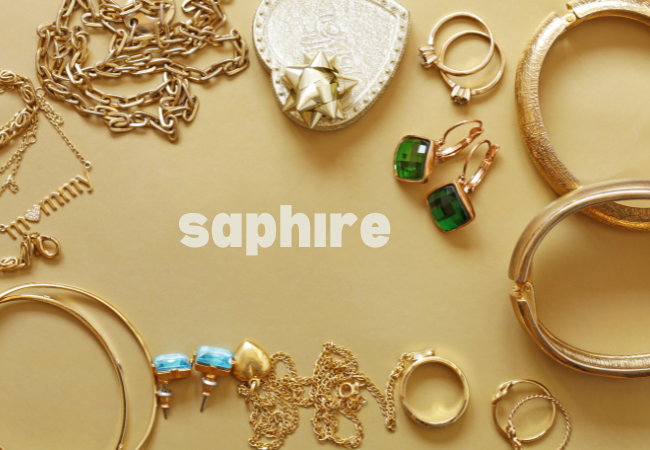The Allure and Mystique of saphıre

History of Sapphire
Saphıre have been cherished since ancient times, symbolizing wisdom, virtue, and good fortune. They were worn by clergy and royalty, believed to guard against envy and harm.
Origin of the Name
The term “sapphire” originates from the Latin word “sapphirus” and the Greek word “sappheiros,” both meaning blue stone. This name has been historically used to describe various blue gemstones, but today it is specific to corundum.
Sapphire vs. Other Gemstones
Sapphire stands out among gemstones for its hardness, surpassed only by diamonds. Its wide range of colors, durability, and luster make it a favorite among jewelers and collectors alike.
Formation and Types of Sapphire
Understanding the formation and varieties of sapphire enhances appreciation for this gemstone’s beauty and rarity.
Geological Formation
Sapphires form under extreme pressure and temperature conditions in the Earth’s crust. They are primarily found in metamorphic and igneous rocks, where aluminum-rich minerals undergo crystallization.
Natural vs. Synthetic Sapphire
Natural sapphires are mined from the earth, while synthetic sapphires are created in laboratories. Both types have identical chemical compositions, but natural sapphires often contain unique inclusions and color variations.
Varieties of Sapphire
Sapphires come in a spectrum of colors, including blue, pink, yellow, green, and even colorless. Each variety has distinct characteristics and appeal, with blue sapphires being the most sought after.
Physical and Chemical Properties
Sapphires are not only beautiful but also remarkable for their physical and chemical properties.
Hardness and Durability
Sapphire is rated 9 on the Mohs scale of hardness, making it incredibly durable and suitable for everyday wear. This property ensures its longevity in jewelry.
Chemical Composition
Sapphire is a variety of the mineral corundum, composed primarily of aluminum oxide (Al2O3). Trace elements like iron, titanium, and chromium give sapphires their various colors.
Optical Properties
The optical properties of sapphire, such as its pleochroism (the ability to show different colors when viewed from different angles) and brilliance, contribute to its allure. Star sapphires exhibit asterism, displaying a star-like pattern when cut properly.
Historical Significance of Sapphire
Throughout history, sapphires have played significant roles in various cultures and civilizations.
Ancient Uses
In ancient Persia, it was believed that the Earth rested on a giant sapphire, giving the sky its blue color. Sapphires were also used as talismans to protect against harm and to attract divine favor.
Symbolism in Different Cultures
Sapphires have symbolized purity, wisdom, and celestial hope across cultures. In medieval Europe, they were believed to protect the wearer from envy and harm.
Notable Historical Sapphires
Famous sapphires, such as the Star of India and the Logan Sapphire, have storied pasts and are treasured in museum collections around the world.
Cultural and Religious Significance
The cultural and religious significance of sapphires is profound and diverse.
Symbolism in Religion
In Christianity,saphıre are associated with heaven and were often used in ecclesiastical rings. In Hinduism, sapphires are believed to align with the planet Saturn and are worn for protection and spiritual insight.
Sapphires in Folklore
Sapphires have featured in numerous legends and myths, often associated with royalty and divine favor. They were believed to bring peace, joy, and wisdom to their wearers.
Modern Cultural References
Sapphires continue to captivate in modern culture, often seen in high-profile jewelry pieces worn by celebrities and featured in films and literature.
Mining and Extraction of Sapphire
The process of mining and extracting sapphires is both fascinating and complex.
Major Mining Locations
The most famous sources of sapphires include Sri Lanka, Myanmar (Burma), and Kashmir. Each region produces sapphires with distinct characteristics.
Mining Techniques
Sapphire mining involves both traditional and modern techniques, from alluvial mining in riverbeds to more advanced open-pit mining methods.
Environmental Impact
Mining activities have significant environmental impacts. Sustainable practices and regulations are crucial to minimize ecological footprints and preserve natural habitats.
Synthetic and Lab-Created Sapphires
Lab-created sapphires offer an ethical and affordable alternative to natural sapphires.
Production Methods
Synthetic sapphires are produced using methods such as the Verneuil process and hydrothermal synthesis. These methods replicate natural conditions to create sapphires indistinguishable from their natural counterparts.
Uses of Synthetic Sapphires
Synthetic sapphires are used not only in jewelry but also in various industrial applications, including watch crystals, optical components, and electronic substrates.
Market Demand
The demand for synthetic sapphires has grown due to their affordability and ethical considerations. They provide an attractive option for those seeking beautiful, high-quality gemstones without the environmental impact of mining.
Uses of Sapphire in Jewelry
Sapphires are a staple in the world of jewelry, valued for their beauty and versatility.
Types of Jewelry
Sapphires are used in various types of jewelry, including rings, earrings, necklaces, and bracelets. Their hardness makes them suitable for daily wear and special occasions alike.
Popular Designs
From classic solitaire settings to intricate vintage designs, sapphires can be styled in numerous ways. They are often paired with diamonds to enhance their brilliance.
Care and Maintenance
Proper care is essential to maintain the beauty of sapphire jewelry. Regular cleaning and careful storage help preserve their luster and prevent damage.
Sapphire in Technology
Beyond their aesthetic appeal, sapphires have practical applications in technology.
Industrial Applications
Sapphire’s hardness and chemical stability make it ideal for use in harsh environments, such as in industrial cutting tools and high-durability windows.
Sapphire in Electronics
Sapphire substrates are used in the production of LEDs and semiconductor devices, providing superior thermal and electrical properties.
Innovations Using Sapphire
Ongoing research and innovation continue to expand the use of sapphire in technology, exploring its potential in new and exciting ways.
Investment in Sapphires
Investing in sapphires can be both rewarding and complex.
Valuation Factors
The value of a sapphire is determined by its color, clarity, cut, and carat weight. Provenance and historical significance can also influence its value.
Market Trends
The sapphire market is influenced by trends in fashion, celebrity endorsements, and discoveries of new deposits. Staying informed about these trends is crucial for investors.
Tips for Investing
Investing in sapphires requires careful consideration and knowledge. Purchasing from reputable dealers, obtaining certification, and understanding market dynamics are key to making wise investments.
Famous Sapphires Around the World
Several sapphires have gained fame for their size, beauty, and historical significance.
The Star of India
The Star of India, one of the largest and most famous star sapphires, is renowned for its striking star pattern and pale blue color. It is housed in the American Museum of Natural History.
The Logan Sapphire
The Logan Sapphire, a stunning 423-carat deep blue sapphire, is part of the Smithsonian Institution’s gem collection. It is known for its exceptional size and color.
Other Renowned Sapphires
Other famous sapphires, such as the Bismarck Sapphire and the Blue Giant of the Orient, continue to captivate gem enthusiasts and collectors worldwide.
Sapphire Care and Maintenance
Proper care ensures the longevity and beauty of sapphire jewelry.
Cleaning Techniques
Sapphires can be cleaned using mild soapy water and a soft brush. Ultrasonic cleaners are also effective, but should be used with caution to avoid damaging the stone.
Storage Tips
Store sapphires separately from other gemstones to prevent scratching. Keeping them in a soft pouch or lined jewelry box is recommended.
Repair and Restoration
Professional jewelers can repair and restore sapphire jewelry, addressing issues such as loose settings and surface scratches to maintain their pristine condition.
Choosing the Perfect Sapphire
Selecting the perfect sapphire involves understanding key quality factors.
Color
The color of a sapphire is its most important quality attribute. The most valued sapphires have a deep, vivid blue color with good saturation and minimal zoning.
Cut
A well-cut sapphire enhances its brilliance and color. Common cuts include round, oval, and cushion, each offering a unique visual appeal.
Clarity
Sapphires typically have inclusions, but eye-clean stones with minimal visible inclusions are more desirable. Clarity affects both the beauty and value of the gemstone.
Carat Weight
Sapphire sizes vary widely, with larger stones being rarer and more valuable. However, quality should not be compromised for size.
Buying Guide for Sapphires
Purchasing a sapphire requires careful consideration and knowledge.
Trusted Sellers
Buying from reputable jewelers ensures the authenticity and quality of the sapphire. Look for sellers with good reviews and certifications from recognized gemological institutes.
Certification
Certified saphıre come with documentation from gemological laboratories, detailing the stone’s characteristics and confirming its authenticity.
Price Range
Sapphire prices vary based on quality factors. Setting a budget and understanding what influences price can help buyers make informed decisions.
Astrological and Healing Properties
Many believe in the mystical properties of sapphires, attributing various benefits to this gemstone.
Zodiac Connections
Sapphire is associated with the zodiac sign of Virgo and is believed to bring clarity, wisdom, and tranquility to its wearers.



